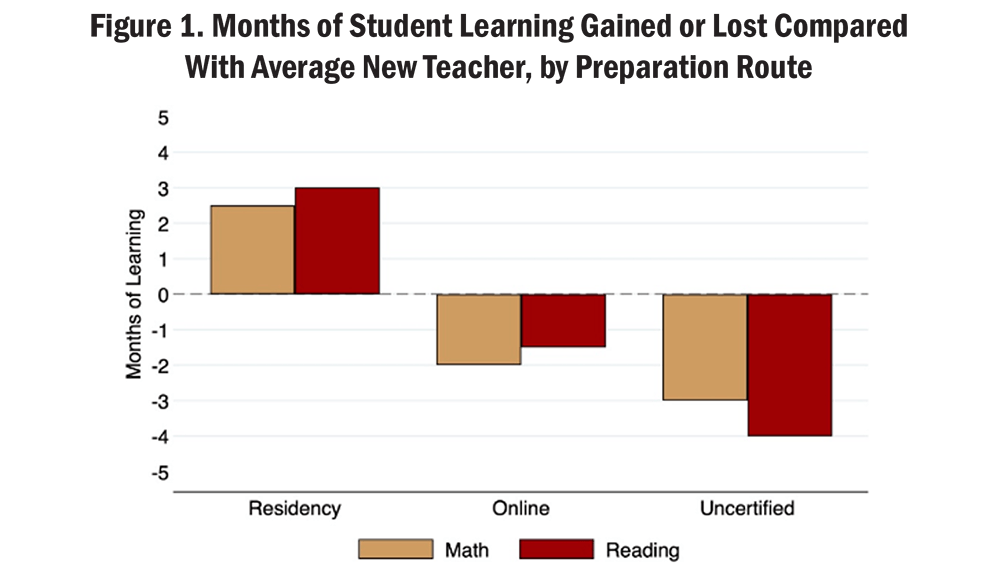Teacher Residencies in Texas

Access the Investing in Texas Teacher Preparation: Key Features of Successful Residency Programs brief to learn more about key features of Texas teacher residencies and the Investing in Teacher Residencies: Sustaining Texas’s Momentum to Prepare High-Quality Teachers brief for more information on outcomes.
What is the state of the teacher workforce in Texas?
Texas has experienced severe teacher shortages for more than a decade, largely driven by teacher attrition, which currently exceeds the national average by more than 50% and accounts for nearly all statewide teacher vacancies each year. In response, Texas districts have been hiring increasing numbers of teachers through alternative routes with little preservice preparation. The hiring of uncertified teachers also has risen sharply. These underqualified and underprepared teachers leave the profession at higher rates, undermining student learning and exacerbating teacher shortages.

A more promising strategy, paid teacher residencies, is a research-validated approach modeled after the medical residency system. Teacher candidates receive financial support during a full year of clinical training alongside an expert mentor teacher while completing their educator preparation program (EPP) credential coursework. Growing evidence indicates that residency program completers are more effective and likely to stay in the profession than teachers who enter through other pathways or without preparation.
How has Texas supported teacher residencies?
Texas has made compelling progress in seeding, sustaining, and scaling up paid teacher residencies. A statewide increase in residencies was accelerated by financial support and technical assistance through the ESSER-funded Texas COVID Learning Acceleration Supports (TCLAS) grant program in 2021. As the TCLAS residency program was implemented, policies were enacted to define, regulate, and support teacher residencies; in particular, the State Board for Educator Certification created a separate, officially recognized residency pathway linked to a new state teaching certificate, the “enhanced standard certificate,” for residency completers. This formal distinction makes it easier for districts to identify residents and residency completers, for state agencies to assess residency outcomes, and for policymakers to understand the impact of residencies on the teacher workforce as they consider future state incentives and opportunities for residency completers.
Based on its definition of a high-quality residency, Texas has incentivized a set of common residency features:
- Residents receive stipends that support their living expenses and enable them to participate fully in their classroom placements.
- Residents are placed in mentor teachers’ classrooms for a full academic year of clinical training in which they co-teach with progressively increasing responsibilities.
- Coursework from residents’ EPPs is aligned with residents’ learning in K–12 classroom placements.
- Experienced mentor teachers receive support in best practices for supporting emerging teachers.
- The EPP and district collaborate closely and have shared ownership over the preparation, support, and success of teacher residents.
- EPP faculty (frequently called site coordinators) are embedded in school districts where they can closely support residents, mentor teachers, and school and district leaders.
- To make hosting paid residents affordable, districts receive technical assistance for “strategic staffing,” where positions (e.g., instructional support staff) are reconfigured to free up funds for resident stipends.
What are the results so far?
Texas has seeded paid residency programs in more than 85 districts through the TCLAS grant program. TCLAS also incentivized a substantial increase in the number of vetted teacher residency programs in the state—those certified as meeting state quality standards and eligible to partner with districts for state grant opportunities—from an initial 15 EPPs in 2021 to 37 in 2024. Vetted teacher residencies are now offered by 30% of all EPPs in the state.
According to Texas-based research, students of teachers prepared through a residency show, on average, 2.5 months of additional learning gains in math and 3 additional months in reading compared to students of an average new teacher. The research found even larger differences in learning gains relative to online-prepared and uncertified teachers, who make up a majority of new-to-the-profession Texas teachers (see Figure 1).
For residents, more rigorous training, supportive coaching, and extensive observation cycles allow for deeper learning. Stipends ease residents’ financial burdens while expanding access for candidates who otherwise would be unable to commit to clinical teaching. Stipends also increase the size of the applicant pool and, as has been shown nationally, increase the racial and socioeconomic diversity within the applicant pool. In the classroom, having a second educator enables more differentiated instruction while also providing the mentor teacher with an opportunity for career growth. At the district level, residencies have positively altered hiring practices: Administrators in residency districts know their applicants’ abilities after what has amounted to a year-long interview.
How can Texas continue the momentum?
The TCLAS residency program provided a promising start toward building robust statewide teacher pipelines and improving students’ access to well-qualified teachers. However, if residencies are to train teachers in quantities that supplant teachers trained through high-turnover, low-quality pathways, residencies must become an option for all districts that want to host them. To support existing residency programs and launch new ones, policymakers can:
- Provide initial state support for resident and mentor teacher stipends in new residency programs and matching grants for residency stipends in districts with existing residencies.
- Provide targeted funding for teacher residency programs in rural and high-need districts using a formula like the Texas Teacher Incentive Allotment (TIA), which identifies high-need districts and provides funding to attract and retain high-quality teachers in those districts.
- Invest in building technical assistance capacity through Education Service Centers. This could help new districts launch paid residencies and support networking and collaboration for existing programs.
- Build on Texas’s new enhanced standard certificate to provide financial incentives for residency completers, such as an extra year of credit on district pay scales or Teacher Incentive Allotment designation.
- Establish more explicit and sustainable pipelines for mentor teachers and residency faculty as new programs come online and established programs continue to operate and grow.
- Provide seed grants to EPPs to enable them to launch residencies with high-quality program features.
